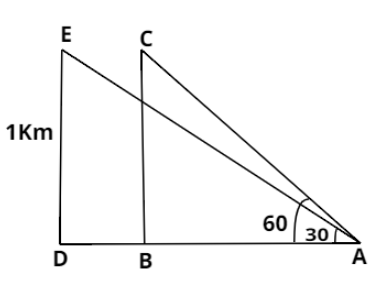
An aeroplane flying horizontally 1 km above the ground is observed at an angle of ${60^ \circ }$. If after 10 seconds the elevation is observed to be ${30^ \circ }$, find the uniform speed of the aeroplane.
Answer
415.3k+ views
Hint: Consider different triangles of different positions of the aeroplane. The distance travelled by the aeroplane in 10 seconds will be the difference between the different positions.
Complete step-by-step answer:

In the above figure, C is the initial position of the aeroplane. Its height above the ground is 1 km. Initial angle of elevation is ${60^ \circ }$. Then in triangle ABC, we have:
$
\Rightarrow \tan {60^ \circ } = \dfrac{{BC}}{{AB}}, \\
\Rightarrow \sqrt 3 = \dfrac{1}{{AB}}, \\
\Rightarrow AB = \dfrac{1}{{\sqrt 3 }} .....(i) \\
$
From the figure, $CE = BD$
Let the uniform speed of the aeroplane is $v{\text{ km/hr}}$. It moves horizontally for 10 seconds and reaches point E. We know, Distance $ = $Speed $ \times $time. Applying this, we’ll get:
$ \Rightarrow CE = v \times \dfrac{{10}}{{60 \times 60}}$
From the figure, $CE = BD$. So, we have:
$ \Rightarrow BD = v \times \dfrac{{10}}{{60 \times 60}} .....(ii)$
From the figure, we have:
$ \Rightarrow AD = AB + BD$
Putting the values of AB and BD from equations $(i)$ and $(ii)$ respectively, we’ll get:
$ \Rightarrow AD = \dfrac{1}{{\sqrt 3 }} + v \times \dfrac{{10}}{{60 \times 60}} .....(iii)$
The angle of elevation of the aeroplane now is ${30^ \circ }$. Thus, in triangle ADE, we have:
$
\Rightarrow \tan {30^ \circ } = \dfrac{{DE}}{{AD}}, \\
\Rightarrow \dfrac{1}{{\sqrt 3 }} = \dfrac{1}{{AD}}, \\
\Rightarrow AD = \sqrt 3 \\
$
Now putting the value of AD from equation $(iii)$, we’ll get:
$
\Rightarrow \dfrac{1}{{\sqrt 3 }} + v \times \dfrac{{10}}{{60 \times 60}} = \sqrt 3 , \\
\Rightarrow \dfrac{v}{{6 \times 60}} = \sqrt 3 - \dfrac{1}{{\sqrt 3 }}, \\
\Rightarrow \dfrac{v}{{60 \times 2 \times 3}} = \dfrac{2}{{\sqrt 3 }}, \\
\Rightarrow v = 60 \times 2 \times \sqrt 3 \times 2, \\
\Rightarrow v = 240\sqrt 3 \\
$
Thus the speed of the aeroplane is $240\sqrt 3 $ km/hr.
Note: The question can be solved in this way only if the aeroplane is moving horizontally. If it is moving at any other angle, the triangles formed will be different than this.
Complete step-by-step answer:

In the above figure, C is the initial position of the aeroplane. Its height above the ground is 1 km. Initial angle of elevation is ${60^ \circ }$. Then in triangle ABC, we have:
$
\Rightarrow \tan {60^ \circ } = \dfrac{{BC}}{{AB}}, \\
\Rightarrow \sqrt 3 = \dfrac{1}{{AB}}, \\
\Rightarrow AB = \dfrac{1}{{\sqrt 3 }} .....(i) \\
$
From the figure, $CE = BD$
Let the uniform speed of the aeroplane is $v{\text{ km/hr}}$. It moves horizontally for 10 seconds and reaches point E. We know, Distance $ = $Speed $ \times $time. Applying this, we’ll get:
$ \Rightarrow CE = v \times \dfrac{{10}}{{60 \times 60}}$
From the figure, $CE = BD$. So, we have:
$ \Rightarrow BD = v \times \dfrac{{10}}{{60 \times 60}} .....(ii)$
From the figure, we have:
$ \Rightarrow AD = AB + BD$
Putting the values of AB and BD from equations $(i)$ and $(ii)$ respectively, we’ll get:
$ \Rightarrow AD = \dfrac{1}{{\sqrt 3 }} + v \times \dfrac{{10}}{{60 \times 60}} .....(iii)$
The angle of elevation of the aeroplane now is ${30^ \circ }$. Thus, in triangle ADE, we have:
$
\Rightarrow \tan {30^ \circ } = \dfrac{{DE}}{{AD}}, \\
\Rightarrow \dfrac{1}{{\sqrt 3 }} = \dfrac{1}{{AD}}, \\
\Rightarrow AD = \sqrt 3 \\
$
Now putting the value of AD from equation $(iii)$, we’ll get:
$
\Rightarrow \dfrac{1}{{\sqrt 3 }} + v \times \dfrac{{10}}{{60 \times 60}} = \sqrt 3 , \\
\Rightarrow \dfrac{v}{{6 \times 60}} = \sqrt 3 - \dfrac{1}{{\sqrt 3 }}, \\
\Rightarrow \dfrac{v}{{60 \times 2 \times 3}} = \dfrac{2}{{\sqrt 3 }}, \\
\Rightarrow v = 60 \times 2 \times \sqrt 3 \times 2, \\
\Rightarrow v = 240\sqrt 3 \\
$
Thus the speed of the aeroplane is $240\sqrt 3 $ km/hr.
Note: The question can be solved in this way only if the aeroplane is moving horizontally. If it is moving at any other angle, the triangles formed will be different than this.
Recently Updated Pages
What percentage of the area in India is covered by class 10 social science CBSE

The area of a 6m wide road outside a garden in all class 10 maths CBSE

What is the electric flux through a cube of side 1 class 10 physics CBSE

If one root of x2 x k 0 maybe the square of the other class 10 maths CBSE

The radius and height of a cylinder are in the ratio class 10 maths CBSE

An almirah is sold for 5400 Rs after allowing a discount class 10 maths CBSE

Trending doubts
The Equation xxx + 2 is Satisfied when x is Equal to Class 10 Maths

Why is there a time difference of about 5 hours between class 10 social science CBSE

Change the following sentences into negative and interrogative class 10 english CBSE

Write a letter to the principal requesting him to grant class 10 english CBSE

Explain the Treaty of Vienna of 1815 class 10 social science CBSE

Write an application to the principal requesting five class 10 english CBSE




